Apple variety Jonagold
Jonagold (Jonagold) - American selection apple tree with fruits of late winter ripening period. Obtained in 1943 at the Geneva breeding station (New York, USA) by crossing 2 varieties - Jonathan x Golden Delicious... In the early 1970s, the variety was sent to undergo an initial test, and since the mid-1980s, in the plantations belonging to scientific institutions of the Forest-Steppe and Steppe of Ukraine, it has undergone an extensive production test. On the territory of southern Polesye, this apple tree was tested mainly on frost-resistant skeleton-formers. It should be noted that initially the new variety did not arouse much interest among American breeders and its trials were completed in the United States back in 1953. In the 1960s, Jonagold was introduced to European countries (Belgium, the Netherlands), where its first large plantations appeared. And only after the active spread of the apple tree throughout Europe, they remembered about him at home. On the territory of the Soviet Union, the variety began to be distributed in the 1970s, and in the 1980s it was grown in all the republics of the USSR. The popularity of this apple tree all over the world has not faded away to this day; its share in the world market accounts for a significant volume of apples sales.
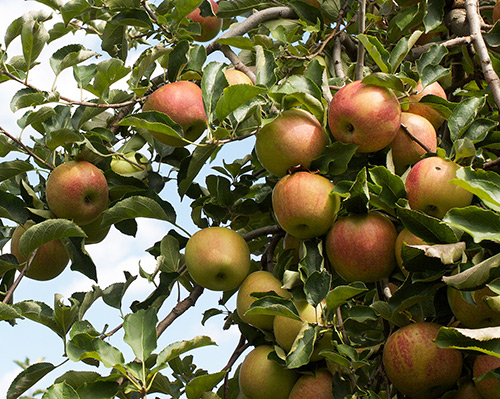
Trees are vigorous, fast-growing. Crohn at a young age is broadly oval, in mature trees - spherical, medium thickened. Skeletal branches, when leaving the trunk, form a wide angle (closer to a straight line). Excitability of the kidneys is above average, the ability to form shoots is average. Fruiting is concentrated on ringlets, fruit twigs and annual growths.
The flowering period is medium. Triploid variety (at least 2 pollinators are required). Through free pollination, from 9 to 21% of the fruits are tied. Among the best pollinators for Jonagold, varieties are distinguished: Jonathan, Idared, Gloucester, Champion, Cox Orange Pepin, Elstar.
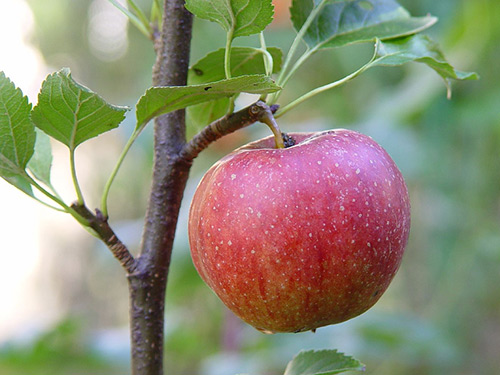
Fruits are of a higher medium and large size (the weight of an apple usually varies from 170 to 220 g, the largest specimens can reach 250 g), one-dimensional, rounded or rounded-elongated, slightly conical, with ribbing at the calyx (better expressed in large fruits). The skin is of medium thickness, smooth, elastic, dense, shiny, with a waxy coating. The main color of the fruits is greenish-yellow, the integumentary color occupies no more than 2/3 of the apple's surface and is expressed through a rather bright blurry-striped orange-red blush.
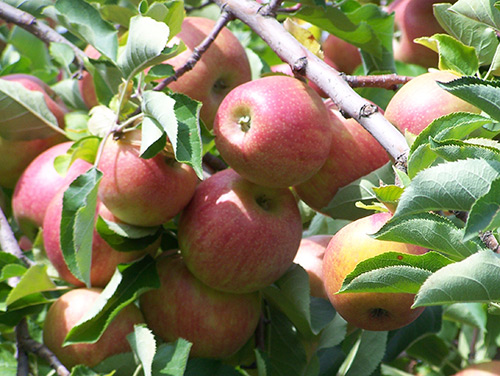
The pulp is yellow, dense, juicy, crunchy, excellent, very peculiar, but harmonious sweet-sour taste, with astringency. Tasting assessment of the taste of Jonagold apples - 4.6 - 4.8 points. A universal variety: fresh, canned, juices, compotes, mashed potatoes, dry powders for baby food, preserves, jams, desserts.
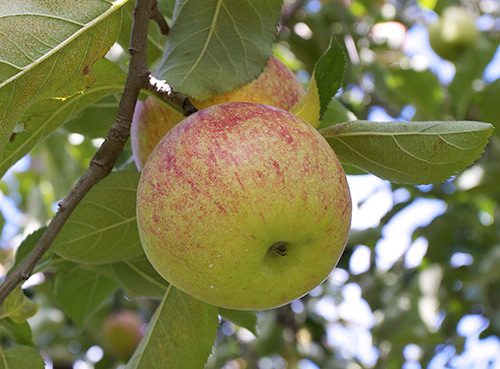
The period of removable fruit ripeness falls in September (often closer to the end of the month, depending on the growing area). It is customary to harvest the crop when the main color of the fruit becomes yellow-orange (without "greenness") with the addition of a pink blush. The fruits reach full maturity in January. The fruits are stored for a long time: in a refrigerator until April. The transportability of the variety is very high.
The early fruiting rate of the apple tree is high: the trees bear fruit from the 3rd year after planting. The yield is also high: from 5 - 7-year-old trees, up to 10 - 15 kg of fruits are harvested, at the age of 10 - 12 years, apple trees yield up to 40 - 55 kg of fruits.
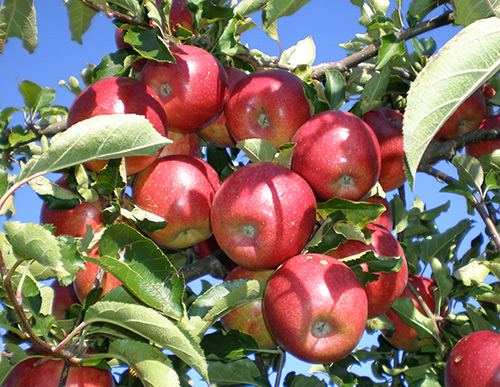
Winter hardiness is low (below average): trees are extremely unfavorable to transfer the change from a normal winter to an extreme one for a particular region.In the conditions of the Crimea, the Steppe and the western forest-steppe, the trees withstand well the winters usual for these regions with decent agrotechnical care on the stocks M.9 and MM.106, while forming rather high yields. In extreme winters, the trees receive significant damage, take a long time and do not fully recover, and the yield decreases markedly. So, for example, in the conditions of the southern Polesie of Ukraine, in the harsh winter of 1986 - 1987. 6-year-old trees on M.3 froze by 3.0 - 4.0 points when the air temperature dropped to minus 35.9 ° C. In the spring, the state of the trees was estimated at 2.0 - 3.0 points: the wood of skeletal and semi-skeletal branches was brown, the proportion of damaged bark on the trunk reached 50 - 70% of the total surface, up to 65% of fruit formations were frozen, some semi-skeletal branches and shoots were observed to fall out. grew very poorly. Later (from 1987 to 1992) the frozen trees never fully recovered, bringing low yields (from 7 to 18 kg / fowl). In 1993, these trees were uprooted.
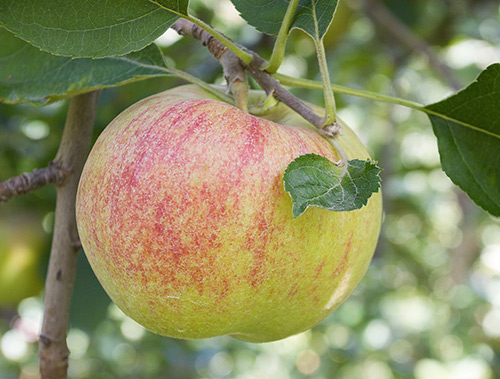
The resistance of the Jonagold apple tree to scab is medium, to powdery mildew - low.
The obvious advantages of the variety are: large, very beautiful fruits with excellent taste; high rates of productivity, early maturity and keeping quality; the possibility of various uses of fruits for culinary and industrial purposes.
Significant disadvantages include: insufficiently high level of winter hardiness and resistance to major diseases.
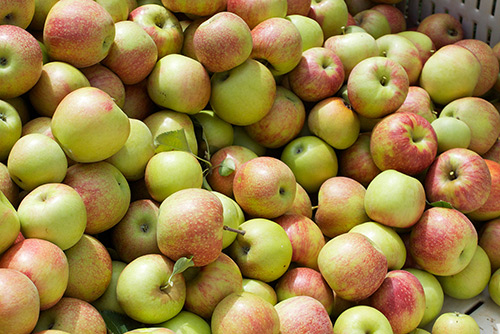
Since the Jonagold apple tree is very popular all over the world, it has numerous clones (there are more than 100 species in total), which, as a rule, differ in a more intense color. They are conventionally divided into 5 groups:
1. Mutants with a bright red striped (streaky) spotty-blurred blush: Wilmut (Wilmuta), New Jonagold (New Jonagold), etc.
2. Mutants with a bright red blurry top coat: Dzhonika (Jonica), Jonagold King (Jonagold King), Nikobel (Nicobel), Goldpurpur (Goldpurpur), etc.
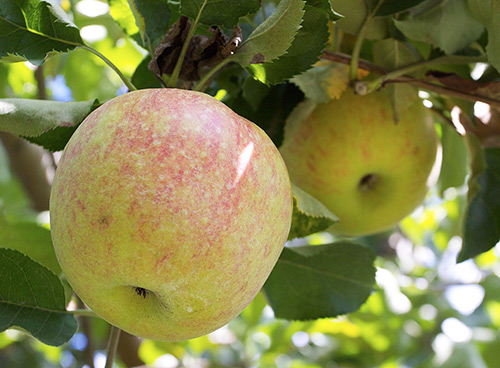
3. Mutants with an average fruit color between bright red and dark red: Novayo (Navajo).
4. Mutants with a dark red blush blurred over the entire surface of the fruit, on the background of which strokes may appear: Jonagored (Jonagored), Jonagold Decosta (Jonagold Decosta), Romagold (Romagold).
5. Mutants with a uniform dark-red blush spread over the entire surface of the fruit: Jomured (Jomured), Marnika (Marnica), Rubinstar (Rubinstar).
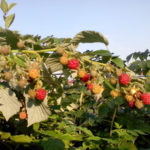
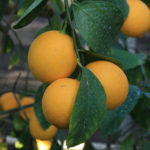

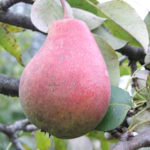

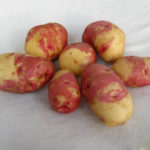



Jonagold has been bearing fruit for the third year already. A very good apple for winter storage. The average yield per tree over these years was about 12 - 15 kg. Fruits are of medium size, round shape, with a reddish-orange barrel, but sometimes this barrel is absent. The apple is juicy, with pleasant taste (sweet with a slight sourness). Due to its hard peel, it tolerates transportation well. Apples are stored in our cellar until about the end of March - beginning of April. Trees do not require special care - standard processing from moth and leafworm. Having 3 trees of this variety on the plot, our family eats apples almost all winter.
An experiment was carried out on this variety with my father. Two more varieties were planted on the main stem - Ranet Simirenko and Jonathan. Vaccinations bear fruit for the second year. And what is characteristic, the "simirinka" scion is not as susceptible to scab as the mother tree Raneta Simirenko, growing nearby.
I have two apple trees of this variety in the garden. I bought it probably ten years ago. Now these are full-fledged young trees, bearing fruit regularly. What I especially like about this variety is that it lies quietly in my basement almost until March and does not lose its taste. The trees themselves grow gorgeous and tolerate pruning well. True, I made a mistake when planting and planted them too close to the nut, over the years the nut has grown and began to shade the apple trees. And they reached out from him, which spoils the crown. We'll have to trim the nut.But I can't get enough of Jonagold himself. Productive and unpretentious!